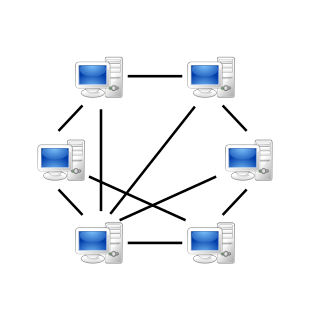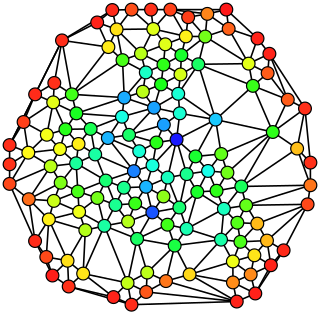See also
| | This disambiguation page lists articles associated with the title Social contact. If an internal link led you here, you may wish to change the link to point directly to the intended article. |
Social contact can refer to:
| | This disambiguation page lists articles associated with the title Social contact. If an internal link led you here, you may wish to change the link to point directly to the intended article. |

Peer-to-peer (P2P) computing or networking is a distributed application architecture that partitions tasks or workloads between peers. Peers are equally privileged, equipotent participants in the application. They are said to form a peer-to-peer network of nodes.

Social network analysis (SNA) is the process of investigating social structures through the use of networks and graph theory. It characterizes networked structures in terms of nodes and the ties, edges, or links that connect them. Examples of social structures commonly visualized through social network analysis include social media networks, memes spread, information circulation, friendship and acquaintance networks, business networks, knowledge networks, difficult working relationships, social networks, collaboration graphs, kinship, disease transmission, and sexual relationships. These networks are often visualized through sociograms in which nodes are represented as points and ties are represented as lines. These visualizations provide a means of qualitatively assessing networks by varying the visual representation of their nodes and edges to reflect attributes of interest.
In telecommunications networks, a node is either a redistribution point or a communication endpoint. The definition of a node depends on the network and protocol layer referred to. A physical network node is an electronic device that is attached to a network, and is capable of creating, receiving, or transmitting information over a communication channel. A passive distribution point such as a distribution frame or patch panel is consequently not a node.

In graph theory and network analysis, indicators of centrality identify the most important vertices within a graph. Applications include identifying the most influential person(s) in a social network, key infrastructure nodes in the Internet or urban networks, and super-spreaders of disease. Centrality concepts were first developed in social network analysis, and many of the terms used to measure centrality reflect their sociological origin. They should not be confused with node influence metrics, which seek to quantify the influence of every node in the network.
In media studies, mass communication, media psychology, communication theory, and sociology, media influence and media effects are topics relating to mass media and media culture's effects on individual or an audience's thoughts, attitudes, and behavior. Whether it is written, televised, or spoken, mass media reaches a large audience. Mass media's role and effect in shaping modern culture are central issues for study of culture.

A construction set is a set of standardized pieces that allow for the construction of a variety of different models. The pieces avoid the lead-time of manufacturing custom pieces, and of requiring special training or design time to construct complex systems. This makes them suitable for temporary structures, or for use as children's toys. One very popular brand is Lego.
In the study of complex networks, assortative mixing, or assortativity, is a bias in favor of connections between network nodes with similar characteristics. In the specific case of social networks, assortative mixing is also known as homophily. The rarer disassortative mixing is a bias in favor of connections between dissimilar nodes.
Triadic closure is a concept in social network theory, first suggested by German sociologist Georg Simmel in his 1908 book Soziologie [Sociology: Investigations on the Forms of Sociation]. Triadic closure is the property among three nodes A, B, and C, that if the connections A-B and B-C exist, there is a tendency for the new connection A-C to be formed. Triadic closure can be used to understand and predict the growth of networks, although it is only one of many mechanisms by which new connections are formed in complex networks.
Social network aggregation is the process of collecting content from multiple social network services into one unified presentation. The task is often performed by a social network aggregator, which pulls together information into a single location, or helps a user consolidate multiple social networking profiles into one profile. Various aggregation services provide tools or widgets to allow users to consolidate messages, track friends, combine bookmarks, search across multiple social networking sites, read RSS feeds for multiple social networks, see when their name is mentioned on various sites, access their profiles from a single interface, provide "lifestreams", and so on. Social network aggregation services attempt to organize or simplify a user's social networking experience, although the idea has been satirized by the concept of a "social network aggregator aggregator".
Social network analysis software is software which facilitates quantitative or qualitative analysis of social networks, by describing features of a network either through numerical or visual representation.

Network science is an academic field which studies complex networks such as telecommunication networks, computer networks, biological networks, cognitive and semantic networks, and social networks, considering distinct elements or actors represented by nodes and the connections between the elements or actors as links. The field draws on theories and methods including graph theory from mathematics, statistical mechanics from physics, data mining and information visualization from computer science, inferential modeling from statistics, and social structure from sociology. The United States National Research Council defines network science as "the study of network representations of physical, biological, and social phenomena leading to predictive models of these phenomena."
A social VPN is a virtual private network that is created among individual peers, automatically, based on relationships established by them through a social networking service. A social VPN aims at providing peer-to-peer (P2P) network connectivity between a user and his or her friends, in an easy to set up manner that hides from the users the complexity in setting up and maintaining authenticated/encrypted end-to-end VPN tunnels.

A biological network is any network that applies to biological systems. A network is any system with sub-units that are linked into a whole, such as species units linked into a whole food web. Biological networks provide a mathematical representation of connections found in ecological, evolutionary, and physiological studies, such as neural networks. The analysis of biological networks with respect to human diseases has led to the field of network medicine.

In graph theory, betweenness centrality is a measure of centrality in a graph based on shortest paths. For every pair of vertices in a connected graph, there exists at least one shortest path between the vertices such that either the number of edges that the path passes through or the sum of the weights of the edges is minimized. The betweenness centrality for each vertex is the number of these shortest paths that pass through the vertex.
Complex contagion is the phenomenon in social networks in which multiple sources of exposure to an innovation are required before an individual adopts the change of behavior. It differs from simple contagion in that unlike a disease, it may not be possible for the innovation to spread after only one incident of contact with an infected neighbor. The spread of complex contagion across a network of people may depend on many social and economic factors; for instance, how many of one's friends adopt the new idea as well as how many of them cannot influence the individual, as well as their own disposition in embracing change.
Rumor is an important form of social communications, and the spread of rumors plays a significant role in a variety of human affairs. There are two approaches to investigate the rumor spreading process: the microscopic models and the macroscopic models. The macroscopic models propose a macro view about this process are mainly based on the widely used, i.e. DK model and MK model. Particularly, we can view rumor spread as a stochastic process in social networks. While the microscopic models are more interested more on the micro intereactions between individuals.
Social network analysis in criminology views social relationships in terms of network theory, consisting of nodes and ties These networks are often depicted in a social network diagram, where nodes are represented as points and ties are represented as lines.

NodeXL is a network analysis and visualization software package for Microsoft Excel 2007/2010/2013/2016. The free version contains network visualization and social network analysis features. The commercial version includes access to social media network data importers, advanced network metrics, and automation. It is a popular package similar to other network visualization tools such as Pajek, UCINet, and Gephi.

Pump.io is a general purpose activity streams engine that can be used as a federated social networking protocol which "does most of what people really want from a social network". Started by Evan Prodromou, it is a follow up to StatusNet; Identi.ca, which was the largest StatusNet service, switched to pump.io in June 2013.
Structural holes is a concept from social network research, originally developed by Ronald Stuart Burt. The study of structural holes spans the fields of sociology, economics, and computer science. Burt introduced this concept in an attempt to explain the origin of differences in social capital. Burt’s theory suggests that individuals hold certain positional advantages/disadvantages from how they are embedded in neighborhoods or other social structures. A structural hole is understood as a gap between two individuals who have complementary sources to information.